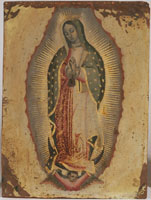Mexico

Introduction:
The Virgin of Guadalupe is a celebrated and well-known image in Mexican culture. Hernan Cortes, who brought the first images of the Virgin Mary to Mexico during the Spanish conquest in 1521, replaced native sacrificial art with images of the Virgin Mary all across Mexico. The myth of the Virgin of Guadalupe began on December 12, 1531 when she appeared to Juan Delgado at Tepeyac and healed his uncle of typhus. Since the apparition, the Virgin of Guadalupe has come to symbolize love, nourishment, health, and motherhood. The Virgin is often depicted as a humble Indian mother and she is seen as a guardian of Mexico and its people. She is an example of Spanish-Indian syncretism, worshiped by indigenous Mexicans and Catholics. The Virgin became the patroness of Mexico in 1746 and was confirmed by the Vatican in 1754.
As the guardian of Mexico, the Virgin of Guadalupe has been used as symbol of nationalist and independence movements. She became a symbol of insurgent groups during the War of Independence in 1810. In 1910, Emiliano Zapata also used the image of the Virgin of Guadalupe as a protector of the popular classes during the revolutionary years.
Veneration:
Veneration occurs at the site of the apparition at Tepeyac, where the Basilica resides. It is believed that by touching the image of the Virgin with hands, faces and bodies, one will receive her powers. Many believers visit the Basilica each year to give thanks to the Virgin of Guadalupe, including Pope John Paul II, who visited twice during his lifetime.
The Virgin of Guadalupe is a spiritual unifier of Mexican people. She has acted as a guardian of Mexico, a healer of its people, and an image of national mobilization. Veneration of the Virgin of Guadalupe, which began in Mexico, also developed a large following in Spain. Today, a large Mexican American population in the United States has expanded her powers of unity, protection and love to the United States.
Works Cited:
- Robert E. Quirk, The Mexican Revolution and the Catholic Church 1910-1929, (Indiana University Press: Canada, 1973).
- Rev. Sean Patrick O’Malley, OFM Cap., A Handbook on Guadalupe, (The Academy of the Immaculate, New Bedford, 1996).
- Warren H. Carroll, Our Lady of Guadalupe and the Conquest of Darkness, (Christendom Publications: Virginia, 1983).
- Jeanette Favrot Peterson, The Virgin of Guadalupe: Symbol of Conquest or Liberation?,” Art Journal, Vol. 51, No4, Latin American Art, 1992,
- Eric R. Wolf, The Virgin of Guadalupe: A Mexican National Symbol, The Journal of American Folklore, Vol. 71, No. 279 (January – March, 1958).
- William B. Taylor, The Virgin of Guadalupe in New Spain: An Inquiry into the Social History of Marian Devotion, The American Ethnologist, Vol. 14, No. 1, Frontiers of Christian Evangelism (Feb., 1987), 9-33.
|

